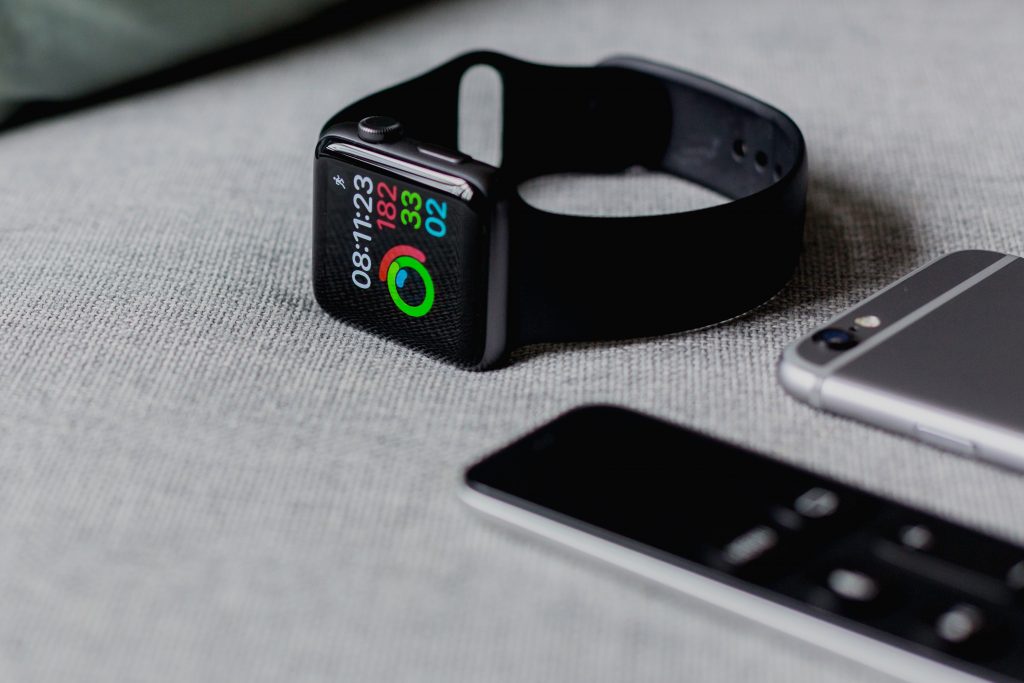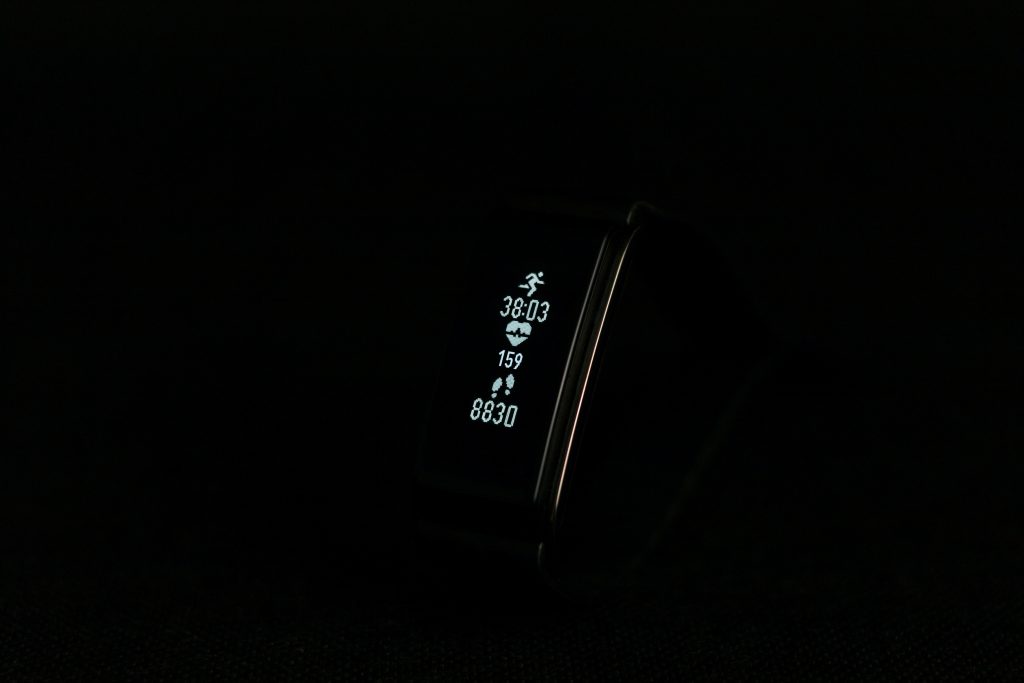“How do I display steps on my Apple watch?”
It’s a common question for today’s fitness enthusiasts.
Apple watches are brilliant accessories for a variety of reasons. They make it quick and straightforward to check your messages when you’re on the move and come with various handy apps to boost your daily productivity. However, perhaps the most significant benefit of the Apple watch is that it helps people from all backgrounds to enhance their physical health.
Apple’s step-counting feature is a popular choice for anyone who wants to keep a close eye on their daily activity. However, the display steps on Apple watch isn’t always as straightforward as it seems.

Here’s your guide to displaying steps and making the most of your Apple watch features.
Table of Contents
Displaying Steps on the Apple Watch
The Apple Watch step counter or pedometer appears in the Activity Rings on the latest version of the Apple Watch. You might also know this app as the “Activity App”. The Activity app is great for tracking information about your workouts, including your heart rate, your distance covered, and the calories you’re currently burning.
However, if you wear your Apple watch consistently, it’s a better source of step counting information than your iPhone.
To find the Activity app, start by pressing the Digital Crown button on your iWatch. It’s the small circular button on the side of the Apple Watch similar to the tool you’d use to set the time on a traditional watch.
Select the app that looks like a set of three colored rings. This is the Activity app. You can scroll down through the app’s homepage to access information about your Exercise, Moving, and Standing statistics. Scrolling will also show you your total distance covered, total steps, and how many “flights” you’ve climbed.

You can check your Apple watch step counter on your iPhone if the two devices pair. Open the Activity app on your iPhone to do this. The app looks the same as it does on your iWatch. If you don’t have the Activity app, find it on the Apple app store first.
Like with the Apple Watch, you’ll need to scroll past the rings showing your movement, standing, and exercise information to find your steps.
Setting up Your Apple Watch for Fitness
While finding your step counter on the Apple watch is easy enough, adding it to your watch face and making sure your data is accurate isn’t as straightforward.
If you’re new to counting steps, the first thing you’ll have to do is set up your Apple Health app with some crucial information about yourself. Apple uses your height, age, weight, and gender to estimate how many steps you take and how many calories you burn.
On your iPhone, open the watch app, and tap health then edit. Enter your information, and tap Done. The Health app will share the information you provide with the Workout and Active apps on your watch. You can also choose to share the data with other third-party apps.

Once you’ve got all of your information set-up, you’ll need to enable location services.
So, why would Apple need to know where you are?
The apps on your watch use GPS tracking to get a more accurate insight into how far you travel, without asking you to enter too much data. The Apple Watch Series 1 doesn’t have the same GPS functionality of the Series 2 or 3. This original watch will only count steps using the Accelerometer if you go walking without your iPhone.
The older iWatch syncs with your iPhone when you get within close proximity of it again.
No matter which model of iPhone you have, you will get more accurate results if you enable location services. On your iPhone, go to Settings > Privacy > Location Services.

Toggle Location Services on if it isn’t already. You can also enable location services for the Apple Watch Services and Apple Watch Workout apps.
Starting Fitness Tracking on the Apple Watch
Location services are only the first step in prepping your iWatch for full functionality. Your Apple Watch and iPhone use an accelerometer to measure your total body movement and track your activity. You need the Accelerometer up and running for times when you can’t quite connect to GPS.
Problems with your GPS are more common than you might think.
There are separate settings to consider on your watch and your iPhone when you’re tracking your steps and activity. For your iPhone, go to Settings, then Privacy, then Location Services. Scroll to the bottom of the list of apps and tap system services.

Check that Motion Calibration and Distance is turned on, then go to Settings > Privacy > Motion & Fitness. Here, check that Fitness Tracking is switched on, along with Health, and any other third-party applications you’re using for fitness tracking right now.
Next, open your Watch app on the iPhone, and go into the My Watch tab. Hit the Privacy option, and make sure that Fitness Tracking is turned on here too.
Add Your Step Counter to Your Watch Face
Having Location Services, Fitness Tracking, and the Accelerometer set up for your Apple Watch should make your step information pretty accurate. That means that you’re ready to display your step information on the face of your Apple watch.
Weirdly, the rings on the Activity app for Apple watch will only show values for exercise, movement, and standing – so there’s no obvious information on your step count here. If you want to get the step information, open the Activity App on your Apple watch, and scroll down by swiping up on the watch face. You can also turn the digital crown if you prefer.

Swiping will show you your total step count for the day. Here, you can also view your exercise, move, and stand progress for the day, distributed into percentages. Apple will even give you information on the total distance you covered, and the flights of stairs you climbed.
If you have an Activity Watch face, then you can view your steps just by tapping on the rings. This saves you the time of having to go to the Home screen and open the app from there.
To choose your watch face with Apple, swipe left or right from edge to edge. This will show you a range of faces, including Activity Analog and Activity Digital.
The Activity Analog watch face will show you your step information when you tap on the circles, as well as your heart rate, your ECG (in some regions), workout information, and more. The Activity Digital face shows you the time in a digital format, alongside your activity progress.
Try a Third-Party App
The Apple Watch is excellent for providing access to tons of useful information, including how much activity you’ve done each day. You can even view a weekly summary from the Activity app on your watch, which shows you your number of steps for each day, and how close you are to beating your goal for calories burned.

Remember, the Apple Watch only shows you the activity and steps done for the day, alongside a summary of the current week. However, you can go into your History tab in the Activity app to find out how many steps you walked on previous days.
If you don’t like the experience you get from the Apple watch, you can always use a third-party app instead. There are tons of apps out there for people who are sick of trying to find a workaround for the Activity app.
Some of the best options include:
- Pedometer++: One of the oldest apps on the Apple Store with a motion processor feature. This app offers daily step goal setting options, and access to a widget that you can display on your watch screen. Pedometer displays workout duration, heart rate, calories burned, and distance covered, as well as steps.
- Pacer: Pacer is a popular fitness app that records and displays daily activity. You can also use the tool to access a personalised fitness plan based on your athletic level. Pacer comes with social components too, like the option to join local groups or take part in walking and workout competitions.
- Footsteps: Footsteps integrates with the Health app on your iPhone. The app gives you an overview of your physical activity, with the option to display information on your home screen. Footsteps also supports access to full activity overviews if you want to check your progress.

If you do choose a third-party app, then you’ll need to give it permission to use your Apple devices for counting your steps. To do this, open the Health app on your iPhone, and tap on Sources. You’ll need to tap on the app you’ve chosen here and turn all categories on for tracking.
Once you have your third-party app set-up, you can Force Touch your watch (long press), to bring up the gallery of faces, and select one with a customization option. Here, edit the complications on your watch screen, using the digital crown to scroll to your app.
How Accurate is the Apple Watch for Counting Steps?
Being able to see how many steps you’ve covered in a glance is excellent. However, if you’re a committed athlete, you’ll probably also want to know how accurate that information is.
The Apple watch measures distance in a very specific way.
The distance travelled and steps taken metrics on your iPhone are two different, but related metrics. During your first day with your Apple watch, you’ll need to provide the activity app with all the basic health information it needs to know about you. This is how your watch converts basic information like steps, into distance, and even calories burned.

Apple uses your age, gender, height, and weight to determine your calorie burn, and potential stride length. That’s how it gives you an insight into the distance you cover with every walk. Although the Apple watch is reasonably accurate, it’s not as accurate as some other trackers.
The dedicated activity trackers that you can get from companies like Garmin and Fitbit allow you to get more in-depth with your information. You can set a custom stride length to help improve accuracy. While you can calibrate your iWatch to make it more accurate, the process is a little different.
Distance and step information in the iWatch are calibrated using GPS data from your iPhone. This establishes an individual benchmark for how many of your steps you’ll cover in an average mile. Once the watch has that information, it can make a more educated guess about your distance travelled.
How to Calibrate Your Apple Watch
Unsure about the accuracy of your Apple Watch? You can always recalibrate it. While wearing your Apple Watch, go to a flat and open outdoor area. You’ll be looking for a good GPS reception here, which means avoiding any large buildings, or cloudy skies.

If you have an Apple Watch Series 2, Series 3, or any version after the Series 3, you only need your Apple watch. However, if you’re still using an Apple Watch Series 1, you’ll need to keep your iPhone with you for GPS connectivity. Hold your phone in your hand or keep it on your arm in a sports band if you need to.
Open your Workout app on the iWatch, and tap on Outdoor walk or run, depending on your chosen activity. Make sure you choose the right activity when calibrating your watch. Set a goal before you start by tapping the three dots. You can then walk or run at your standard rate for about 20 minutes.
If you don’t have the time to do a full 20-minute workout at once, you can combine the calibration into numerous settings. If you often workout at different speeds, you can also calibrate at each of your chosen speeds for better accuracy.
This quick calibration improves the accuracy with which the Apple watch can determine how far you’re running or walking. The calibration is also helpful for improving the accuracy of calorie burning and exercise calculations too.
Other Ways to Boost the Accuracy of your Apple Watch
Devices like the Apple Watch are subject to a huge number of firmware, software, and hardware issues that can impact the accuracy of your step count. Manufacturers are constantly tweaking to make your experience better, but nothing is ever 100%.

There are things that you can do to boost your chances of more accurate measurements, however. For instance, your Apple watch uses the personal information provided by you to calculate metrics for daily activity. You can help by keeping your personal information up-to-date.
If your height, weight, or age changes (which it often will), update this on your iPhone. Open your Apple watch app, select the My Watch tab, then choose the Health and Health Profile to update the information. Other ways to increase accuracy include:
- Make sure you earn exercise credit: Every full minute of movement that exceeds the intensity of a walk adds towards your move and exercise goals. To make sure that you’re gaining the right credit, make sure that the arm your Apple watch is on swings naturally. You don’t have to move your arm excessively. If you need to keep both arms steady, open the app on your Apple watch and tap on Outdoor walk within the workout app. This will use information like the heart-rate sensor, GPS, and Accelerometer to access accurate information on the distance you cover.
- Check wrist detection: Another way to boost the quality of your Apple watch readings is to turn on wrist detection. If this feature is switched off, you won’t get notifications, and your Apple Watch can’t track standing progress. Check the setting by opening the Apple Watch app on your iPhone. Click on the My Watch tap, and ensure you have Wrist Detection active.
- Check your watch fit: Your Apple Watch needs to fit properly if it’s going to gather information correctly. Ensure your wrist strap isn’t too loose or too tight, and that it gives your skin plenty of room to breathe. This will help to give you a more comfortable walking experience, while making the most of the sensors on the watch. You might want to tighten your watch slightly for workouts and loosen it a bit for relaxing. The sensors also only work if you wear your Apple watch on your wrist, not hanging around your belt loop.

What Else Impacts Your Apple Watch Steps?
If you want to get an accurate rating of everything from heart rate to seps, make sure that your watch is fitting snugly on your rest, and avoid turning power saving mode on during a walk or run. Power saving mode switches your heart-rate sensor off.
To see if you’ve got power saving mode on, open the Settings on your smart watch and tap on Workout. You can see Power Saving mode here. If you turn off heart rate mode in your Privacy settings, you also won’t get a heart rate.
Remember, other factors can affect your activity readings, such as:
- Environment: The amount of blood flowing through your skin can influence the Apple watch heart rate sensor. If you’re exercising in the cold, the accuracy of your reading might drop too.
- Motion: The type of movement you’re doing impacts your heart rate sensor performance too. Rhythmic movements like cycling and running give better results than irregular ones. Activities like boxing and tennis aren’t ideal for step counting.
- Temporary changes: Weirdly, Apple confirmed that the Apple watch can struggle with accuracy for people with tattoos. The pattern, ink, and saturation of certain tattoos block the light from the sensor, making reliable readings tough.

Ready to Watch Your Steps?
The Apple Watch is a fantastic tool for those who want to keep track of their health and fitness. However, just like any device, it’s important to ensure you know how to use this product properly. The guidance above will tell you everything you need to know about using your step counter and making the most of the Apple Watch for step tracking.
